Excerpts from Jim Conrad's
Naturalist Newsletter
from the September 22, 2018 Newsletter issued from Rancho Regenesis in the woods ±4kms west of Ek Balam Ruins; elevation ~40m (~130 ft), N~20.876°, W~88.170°; central Yucatán, MÉXICO
GRASSLEAF SPURGE
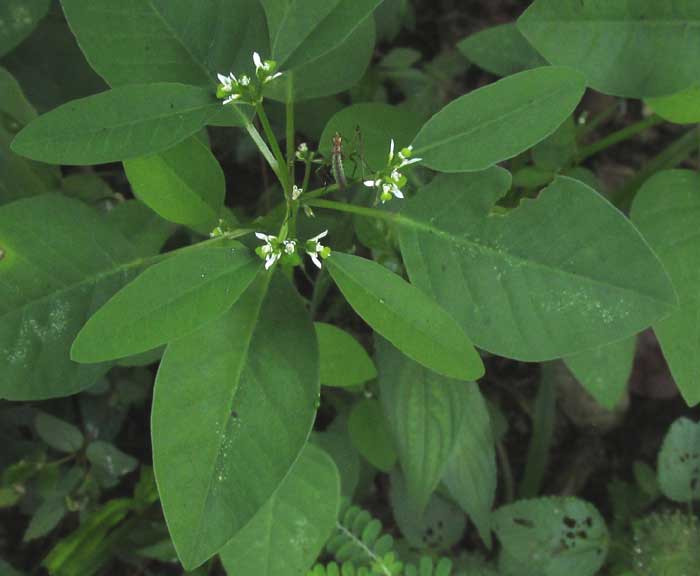
Beside the rancho's entrance gate, shaded by the big Purple Allamanda bush, there grows a weedy spurge, spurges being members of the huge genus Euphorbia (more than 2000 species recognized, with 32 species listed for the Yucatan Peninsula) in the appropriately even bigger Spurge or Poinsettia Family, the Euphorbiaceae. Euphorbia species are easy to recognize because they all bear flowers in a unique kind of flowering structure, but because of the large number of species, figuring out which Euphorbia you have is often hard.
At the excellent Malezas de México website (Weeds of Mexico), which provides pictures of Mexican weeds, I tried to match our rancho weed with one of the 15 Euphorbia species listed there. Actually, I only checked 14 species, because one of them was named Euphorbia graminea, and the graminea part in that name indicates that the plant is "grasslike." And nothing about our gate species suggested a grass, as you can see at the top of this page.
A closeup showing this plant's weird flowering structure is shown below:
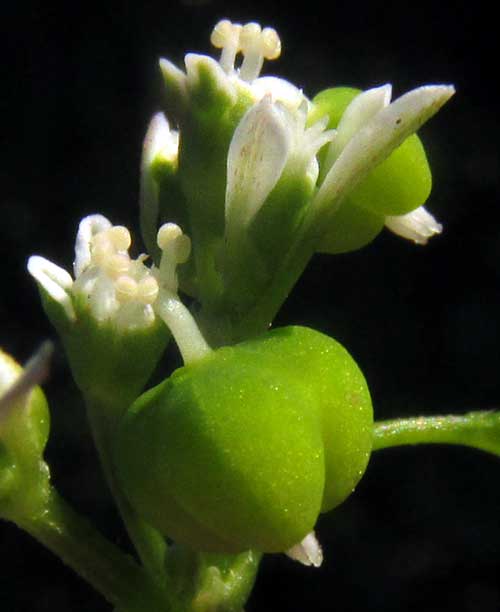
In that picture, the object looking like a green tomato occupying the image's lower half is an ovary, the future capsular-type fruit. It hangs on a curved, white stem, or pedicel, issuing from a green, cuplike structure, the involucre. Also arising from inside the involucre are stamens. Euphorbia flowers are unisexual, the ovary being what's seen of the female flower, and the stamens being what's seen of the male flowers. And each male flower produces only one stamen. In other words, inside the involucre there are several male flowers, and the single female flower, with her ovary hanging outside the flowering structure. The flowering structure is called a cyathium, and when you see it, you have a Euphorbia.
Identifying this species took more time than usual because it turned out that our gate Euphorbia was indeed EUPHORBIA GRAMINEA, the one species on the Mexican Weeds page I hadn't looked at because it didn't look like a grass. It turns out that this is a very variable species. If it's growing in a dry place with abundant sunlight its leaves are slender (from 3mm or 1/10th inch wide), but if it's in the shade during the rainy season, like ours, it looks like what our images show. In English Euphorbia graminea is known as the Grassleaf Spurge, and is distributed across the US southern tier of states south through Mexico and Central America and much of South America, plus it's an invasive weed in the Caribbean, Asia, and the Pacific Islands.
In recent years an ornamental cultivar has been produced of Euphorbia graminea, marketed under the trade name "Diamond Frost." On the FloriData.Com webpage for the species, I read that "Diamond Frost" is prized for the abundant and long lasting large white bracts of its cyathia , and that it never stops blooming. It's described as the most common variety of grassleaf spurge in commerce today. It grows into mounds up to 5ft (1.5m) across.
In Mexico it's used as a forage plant, and the plants when young can be eaten by humans.
Entry from field notes dated June 29, 2023, taken along one-lane gravel road in valley between Puerto del Zenthé and Chavarrías in mountainous area with a maze of roads too complex to say how to get there; in general it's in the mountains of east-central Querétaro state, municipality of Cadereyta de Montes, 12 straight-line kms due east of Vizarrón de Montes but much farther by twisting roads; juniper-scrub forest; limestone bedrock; elevation ~2860m (~9400 ft), Querétaro, MÉXICO, (N20.84122°, W99.60509°)
A HIGHLAND MEXICAN VARIATION
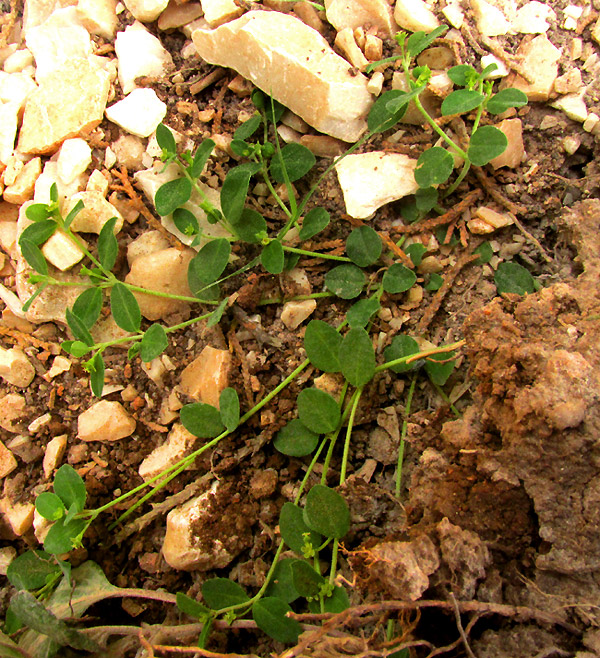
On a small pile of mixed gravel and dirt looking like it had been dumped alongside the gravel road, the above spurge, genus Euphorbia, was doing well. Later I'd identify it as Euphorbia graminea, which we'd seen in the Yucatan {above entry}, but looking somewhat different. The Flora of North America describes this species as "... a variable and taxonomically complex entity whose boundaries are not well defined and are in need of further study" so here's more variation for future studies.
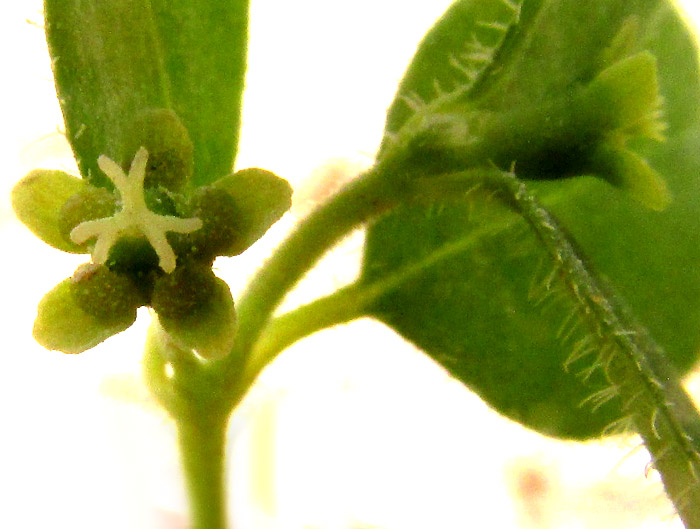
It's a young plant, on which gland appendages hadn't yet turned white, assuming that they'll do so. Pictures on the Internet overwhelmingly show the bowl-like cyathia of this species with four glands, and the Flora of North America numbers them (1–)2–4, but ours bore five. The Flora fanerogámica del Valle de México, the best current treatment of euphorbias in upland central Mexico, gives their number as four or five. The gland appendages were yellowish-green, probably to turn white later. Our Yucatan plants were hairless, but you can see that these upland Querétaro plants bore long hairs, though somewhat sparsely.

Above you see that our flowers' ovaries and stamens hadn't yet emerged from the cyathium.
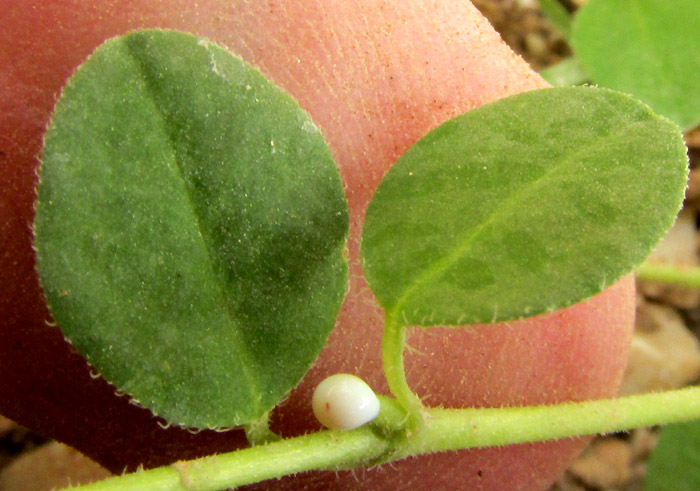
Leaves were broadly oval and sparsely hairy. Note the stipule below the drop of white latex.
The Flora del Bajío agrees that with regard to Euphorbia graminea we're dealing with a complex of species needing a conscientious revision -- "Se trata de un complejo de especies que requiere de una revisión concienzuda."